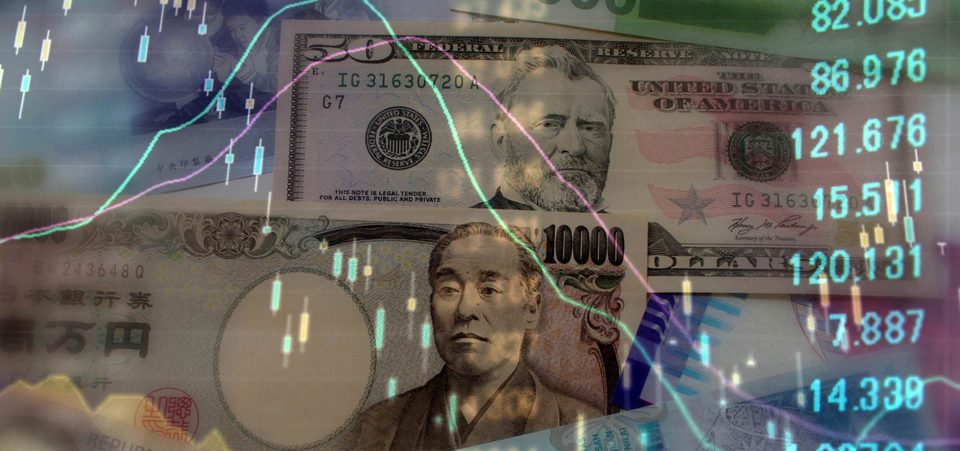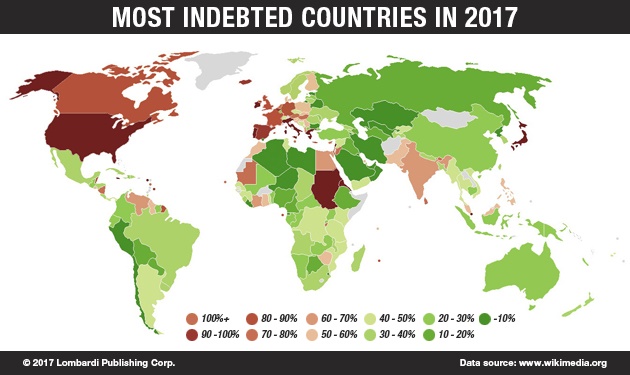The U.S. Is One of the Countries with the Most Debt in 2017
The world has not yet fully recovered from the subprime crisis of 2007/2008 and the recession it caused. One of the most stubborn problems of that legacy has been debt. The percentages and the rankings may have changed somewhat, but the countries with the most debt in 2017 have not changed considerably in the past few years.
Meanwhile, many countries in debt have not been able to curb it since the 2007/2008 crash. In fact, they have increased their levels of debt. One of the most surprising aspects about debt is that some of the countries that have the most are also among the richest.
If you’re wondering which country has the most debt, don’t bet on it being a developing country in Africa or South America. It will shock many to find out that Japan holds that dubious honor. Yes, the very same Japan where people work so hard they have generated a new and deadly disease that has no translation in English: Karoshi. Roughly, it means “death from working too much.”
Japan is also such a huge global exporter of desirable goods and technology. Thus, one of the first things about debt in relation to gross domestic product (GDP) is that virtue, technology, and high average educational achievements do not necessarily prevent or reduce indebtedness.
Before examining why that might be, note that the ranking below represents debt as a percentage of GDP rather than the total amount of debt. GDP represents the total wealth produced or generated during the year (in this case, 2016) in a given country.
See if this list of countries with the highest level of government debt (based on end 2015 statistics) matches your guesses. Chances are, you will be surprised at who made the cut.
Countries with Highest Debt as Percentage of GDP
| RANK | COUNTRY | % OF GDP |
| 1 | Japan | 250.00 |
| 2 | Greece | 176.90 |
| 3 | Lebanon | 139.00 |
| 4 | Italy | 132.70 |
| 5 | Portugal | 130.40 |
| 6 | Jamaica | 128.40 |
| 7 | Cape Verde | 123.00 |
| 8 | Bhutan | 118.60 |
| 9 | Cyprus | 105.67 |
| 10 | Belgium | 106.00 |
| 11 | Singapore | 104.70 |
| 12 | United States | 104.17 |
(Source: “Country List Government Debt to GDP,” Trading Economics, last accessed on March 29, 2017.)
Clearly, Japan has become the most indebted country in the world. There’s not even room for argument. Enduring the weight of a debt that was last estimated at 250% of its GDP, Japan far and away leads the field of contenders for the top 10 countries with the most public debt.
China: One of the Biggest Holders of U.S. Debt Creates Risk
Based on GDP, Japan is the world’s third-largest economy behind the United States and China. Japan has endured a long period of sluggish growth since the 1990s. Two disasters have contributed to deepening Japan’s economic stagnation. One was the international financial crisis that followed the collapse of Lehman Brothers Holdings Inc. in 2008.
The other was an earthquake and tsunami on 11 March, 2011 that would have knocked out a poorer country. Japan suffered deep moral and material damages on that day. Still, even as the Japanese economy continues to remain among the most developed, debt lingers. In fact, it keeps rising uncontrollably. Not a few years ago, it was 225% of GDP. Now, it’s at 250%!
Japan has a bigger debt-compared-to-GDP gap than even Greece, the country whose credit crunch threatened to bring down the European Union in 2015. The sources of Japan’s debt are multiple and have filled pages of recent economics tomes.
Still, one of the main problems has been the value of Japan’s currency, the yen. Japan’s economy is still largely driven by its ability to export. The high yen has made Japanese goods less competitive, especially in Asia.
Internal consumption has lingered for years because of low inflation. In other words, wages have not increased sufficiently, reducing appetite for individual spending. The problem has worsened because the Japanese, who once were among the world’s top savers, spend everything they earn on daily living. (Source: “Japan’s Recovery Is Complicated by a Decline in Household Savings,” The New York Times, March 19, 2015.)
But, Japanese national debt still has a major redeeming factor. Indeed, it’s less toxic than other countries that face less daunting debt numbers. The financial markets don’t worry too much about Japan because domestic, rather than foreign, investors hold most of its debt. That’s a remarkably different and better situation than the United States faces.
China owns almost 30% of the $3.8 trillion of U.S. national debt held by foreign entities. Japan owns a similar chunk. Note, the total U.S. debt approaches $20.0 trillion, which, according to the table above, stands at over 104% of GDP. Last December, Japan replaced China as the biggest foreign holder of U.S. national debt. Rising national debt is a major risk.
That’s not necessarily good news. It signals that U.S. national debt creates significant political risk. It limits President Trump’s margin of maneuverability in any forthcoming military or economic confrontation with China. Japan relies on U.S. power in Asia. Ever since the end of WW2, it has operated as one of America’s closest allies—now even more, given North Korea’s nuclear ambitions.
Yet, China remains one of Washington’s main bankers because it holds U.S. debt in the form of Treasuries (or U.S. government bonds). Here’s the game China can play to virtually hold the U.S. a hostage of its debt. China can buy or sell those Treasuries at will to further its own political and economic goals.
Trump was not wrong to accuse China of engaging in a currency war with the United States. Beijing is doing just that and debt is the American vulnerability it exploits. When China wants to raise the value of its currency, the yuan, it sells its foreign currency reserves. In the case of the dollar, those reserves are in the forms of Treasuries.
Vice-versa, when China wants to lower the yuan to gain a trade advantage, it buys Treasuries. Now, if Trump wants to proceed with his isolationist plan to discourage imports from China, the Chinese can make him pay dearly. They can buy more Treasuries, lifting the value of the dollar, reducing the appeal of American products abroad by making them more expensive.
There’s more. China can have an even more direct role on U.S. GDP—and therefore national debt—when it sells Treasuries. By weakening the value of the dollar, it encourages the Federal Reserve to raise interest rates, which at an inopportune moment, can slow the rate of economic growth.
Rising National Debt Hampers Sovereign Controls on Economy
Even if the U.S. debt ranks outside the top 10 (it’s 12th, according to above rankings), it remains just as vulnerable as if it were No. 1. Moreover, the United States national debt, has not stopped growing, facing a current growth rate of some $14,000 per second in interest. Simply, U.S. debt is at the highest level ever since WW2, which was the highest level in history at 121.70%. (Source: “National Debt of United States,” National Debt Clocks, last accessed March 29, 2017.)
All it would take is another war or major natural emergency to boost that national debt beyond the record set in the 1940s. Moreover, given that Trump has proposed cutting U.S. taxes across the board, government revenues would decrease. The U.S. Treasury may have to issue more debt to sustain the dollar and the Federal Reserve would lift rates faster to prevent inflation. (Source: “Details and Analysis of Donald Trump’s Tax Plan, September 2016,” Tax Foundation, September 19, 2016.)
That said, if you are wondering which country owes the most money—has the largest public debt—the answer might surprise you. It’s not China and it’s not an impoverished and badly run country like Zimbabwe. It’s the United States. At over $19.0 trillion in debt, it owes the most. Indeed, the second biggest debtor, the United Kingdom owes about $2.0 trillion. (Source: “National Debt of United Kingdom,” National Debt Clocks, last accessed March 29, 2017.)
The Cases of Italy, Greece, and the Eurozone
The risks of high debt-to-GDP margins are illustrated by two of the top ten in the ranking above: Greece and Italy. These two Mediterranean countries and members of the Eurozone have vastly different economies. Italy is one of the world’s top seven industrial powers and richest countries. Greece, meanwhile, has a vastly smaller and more tertiary sector based economy.
Yet both Greece and Italy are struggling with debt. Of the two, perhaps, Italy is the greater paradox, because it has one of the highest levels of taxation. In fact, low taxation (what Trump wants to do) tends to boost GDP-to-debt ratios. Singapore, for example, has a very high debt level (it ranks 11 in the list) because it has a policy of very low taxation.
The financial crisis of 2008, whereby governments intervened to the tune of trillions to prop up banks, exacerbated debt levels everywhere. That explains Belgium. But the dilemma of Greece and Italy comes from debt and their relationship to the Euro. Were Greece and Italy to leave the Eurozone, they would have to pay back their high amount of debt with their old currencies (the drachma and lira respectively).
That would almost be impossible, Italy and Greece out of the Eurozone would endure a public debt crisis such as what happened to Mexico (1995), Russia (1998), and Argentina (2000). In Europe, the debt crisis was triggered by bonds and the ECB’s refusal to back them up (in the case of Greek ones).
Meanwhile, Italy, Greece, and Spain have borrowed a lot of money from German banks. That’s why Germany has put so much pressure on their respective governments to enact austerity measures, raising taxes and selling assets. Greece and Italy, as the most indebted countries in the Eurozone, could spark the next major financial crisis.
Paradoxically, their debt levels, prevent these countries from leaving the Euro to pursue more growth oriented policies exploiting the lower value of their alternative currencies—as China does. Meanwhile, Greece has not actually resolved its public debt crisis; it has merely delayed it. Thus, Athens is a public debt time bomb that could unleash the next global financial crisis.







